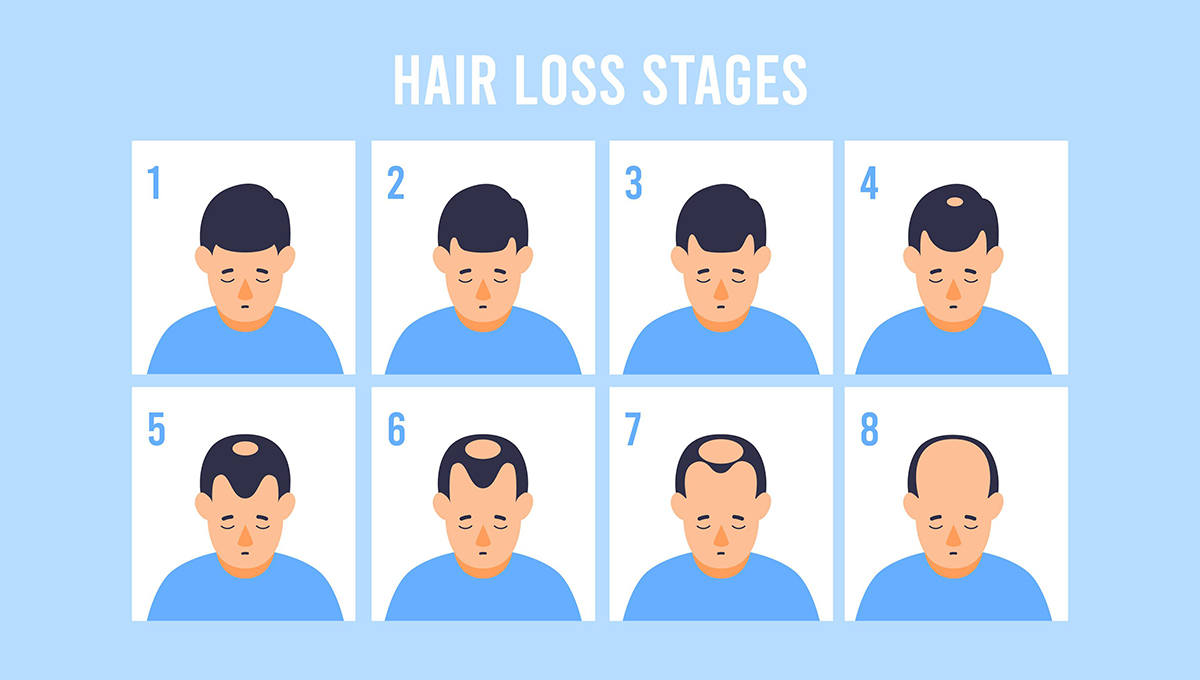
Are you or your partner experiencing thinning hair and excessive hair fall? Don’t worry, taking the right measures in the early stages can actually put a stop to the nightmare otherwise known as “baldness”!
Wondering when does male pattern baldness start? Male pattern baldness, AKA androgenetic alopecia, is a common condition that affects many men. About 50% of American men experience this by the time they reach their 50s. While the condition has no physical impact, one can develop low self-esteem.
If you notice any signs of male hair loss, see a professional. Early detection is crucial in preventing hair loss and maintaining good hair health.
What Causes Male Pattern Baldness?
Your first step to preventing hair loss is to identify its causes and how does alopecia start. Androgenetic alopecia, a hereditary condition influenced by genetics and testosterone (a male hormone), is a common cause of male pattern baldness.
If your dad has this condition, you almost certainly have this fear - Will I go bald if my dad is? Well, we cannot deny the role of genetics in this. Chances are high that you will inherit the condition if you have a family history of baldness. That said, not all men will become bald if they have a family history of baldness.
Dihydrotestosterone (DHT) plays a significant role in causing male pattern hair loss. It's a hormone produced during the conversion of the testosterone hormone by an enzyme called 5-alpha reductase.
This hormone negatively impacts hair follicles, causing them to shrink over time. As these hair follicles start shrinking, they eventually die and cannot produce new hair at all. The shrinkage of the hair follicles leads to shorter hair growth cycles, causing hair to become thinner and finer. In essence, DHT is the major culprit to blame for male pattern baldness.
Other factors can contribute to the loss of hair over time, too. Some of them include:
-
Hormones: Hormonal imbalances in men can disrupt the hair growth cycle. This imbalance can occur due to several reasons. You may be taking some medications or have a thyroid disorder that can cause hormone levels to fluctuate.
-
Lifestyle: Poor diet, excessive stress, and hair styling can weaken hair follicles.
Existing health conditions: Losing hair is common if you have high blood pressure or scalp infections.
When Does Male Pattern Baldness Start?
There's no definitive answer to the question - What age do men start balding or when do men start balding? However, one may start experiencing noticeable hair loss or receding hairline as early as their late twenties or early thirties. It varies from person to person. Some may begin to lose hair earlier in their life. Others may not become bald until later in life. You want to watch out for these common early signs of hair loss:
-
Receding hairline on the temples is the first sign of hair loss
-
Hair starts becoming thinner and finer, especially on the crown of the head
-
Excessive hair loss during combing or taking a shower
Let's have a look at the factors affecting the onset of hair loss:
-
Genes you inherit from your parents
-
Blood thinners and steroids have a role to play
-
Poor dietary habits
-
Stress
-
Fungal infections on the scalp
According to the American Hair Loss Association, one out of every four men with hereditary hair loss starts losing hair before they turn 21. Only 16% of men in their late teens and early 20s experience significant hair loss, which jumps to 53% for men in their 40s.
How to Recognize the Early Signs of Balding
How to tell if I have a receding hairline? Or what does balding look like? Identifying the early signs of balding is the first step toward preventing baldness. Look for these key indicators:
Keep tabs on your hairline in the temples. It could be a sure sign of balding if it's becoming more noticeable. Look for bald spots on your scalp. If you’re really concerned, maintain an image journal with bi-weekly or monthly images of your hairline over the time. That way you can be sure if your hair fall is seasonal or it’s a genuine cause for concern.
Pay close attention to your hair's overall density. If you notice that your hair has become thinner than it used to be, this might be cause for concern.
Wondering how much hair shedding is normal? Our hair sheds as part of our natural hair growth cycle. But if you notice too much hair shedding on your pillow or in the shower, it can be a sign of thinning hair male pattern baldness.
Prevention Strategies for Male Pattern Baldness
Male pattern baldness is a condition that you can keep in control by incorporating specific changes into your daily routine. This is a list of things that works effectively for thinning and balding hair.
1. Using Hair Regrowth Devices and Hair Loss Treatments:
Mychway's hair growth scalp care hats effectively combat hair loss. Instead of harsh chemicals or invasive procedures, they use gentle, light-based therapy.
They emit dual wavelengths of light: red and near-infrared. The red light penetrates deep into your skin, stimulating cell growth and rejuvenation. It stimulates your hair follicles to start producing new strands.
Near-infrared light is more focused on repairing and strengthening. It's like a deep tissue massage for your scalp, helping to improve blood flow and nourish your hair follicles.
2. Maintaining Scalp Health:
How can you prevent baldness? More often it is just bad scalp hygiene that’s causing your hair loss. Maintaining the health of your scalp and strong roots is a must. To prevent hair loss, use a mild shampoo. Refrain from scrubbing hard to prevent scalp irritation. Hydration is super important for your scalp. Use a hydrating scalp conditioner or serum to keep it moisturized and healthy.
3. Lifestyle Changes:
The importance of a balanced diet cannot be overstated. To keep your hair from losing, it's essential that you intake foods good for hair health. Intake of vitamins, minerals, and protein to support hair growth.
Avoid stress, as an excess can lead to premature balding. Meditate, exercise, or practice yoga daily.
Last but not least, avoid excessive heat styling and washing. This can damage hair and accelerate hair loss.
4. Medical Interventions:
Minoxidil and finasteride are some medications you can take to stimulate hair growth. You can also undergo hair transplant therapy to restore hair (especially for those with excessive balding and hair thinning).
Treatment Options for Male Pattern Baldness
There are various treatment options available to address male pattern baldness. Here is a brief overview of each treatment:
-
Medical Treatments: You can try medications to prevent hair loss and stimulate growth. Red light therapy is also beneficial in treating hair loss issues. Make sure you consult a doctor before considering any of these options.
-
Surgical Options: If you are okay with surgical procedures, you can talk to a trichologist (hair doctor) about hair restoration and transplant procedures. They are naturally more expensive and are normally suggested in extreme cases.
-
Esthetic Treatments: Hair styling, hair extensions, or scalp micro-pigmentation are suitable for those willing to improve the appearance of their hair.
Natural and Alternative Treatments: A healthy diet can be a natural way to support hair growth. You may want to take supplements to promote hair growth. Some prefer using home remedies—they practice using apple cider vinegar or onion juice.
Conclusion
Summary of Key Points:
-
Hair loss is influenced mainly by genetics and the DHT hormone.
-
Identifying early signs of hair loss is crucial for effective treatment and prevention.
-
There are many ways to address hair loss, from surgical procedures, medications, and hair regrowth devices to lifestyle modifications.
If you notice any signs of hair loss, consult a healthcare professional or dermatologist. Early detection and intervention can significantly improve your chances of managing hair loss. Remember, you are not alone, and there are effective strategies to address this common condition.
FAQs
1.When do men start losing hair?
Several factors influence this condition. According to the American Hair Loss Association, one out of every four men with hereditary hair loss starts losing hair before they turn 21. Some people experience balding as early as their early twenties, while others may develop it later in life.
2.Can male pattern baldness be prevented?
To some extent, yes! While it is a genetic condition, early detection can help you prevent hair loss. Consult a trichologist if you notice any receding hairline or excessive hair loss.
3.Do hats make you bald?
No, Mychway's hair growth care hats are designed to improve blood flow in the scalp. They are suitable for those who want a non-invasive and effective way to grow hair.
4.Does high blood pressure cause hair loss?
Certain health conditions may influence the cause of hair loss. If you have high blood pressure and concerns about losing hair, it's best to consult a doctor. Treat the root cause of hair fall, in this case, high blood pressure, to see improvements in hair condition.
5.What hormone causes hair loss?
DHT hormone in men is the main culprit behind hair loss. When this hormone attaches to the receptors of the hair follicles, it causes them to shrink and eventually die.
6.Can weight loss cause hair loss?
Yes, it's possible that you may experience hair loss if rapid or excessive weight loss happens. The health of your scalp and hair is intricately connected to your gut health and diet. Consult a dietician if you are concerned with ill-effects of your weight loss journey.
7.Is male pattern baldness genetic?
Yes.Genetics is one of the main causes of hair loss, see definitive data here.


